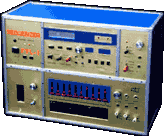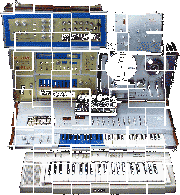| The Instrument Museum | ||
| László Kovács - the leader of Force Majeure - talks about the beginnings: "In the early 1980's I started to experiment with making instruments and studio equipment. At that time, serious electronic instruments were not available, but even if they had been, I wouldn't have had the money to buy them. So there was no alternative - I had to try and build them myself. My experiments were based on my own ideas and I also got significant help from a digital IC atlas and 'Gábor Örlei: Electronic Synthesizers', a basic, but comprehensive book. During that period these two books were my Bible, and from them I found out about the basics of electronics, the concept of the 12th root of 2, the voltage-controlled -oscillators, -filters and -amplifiers. In the shops it was only possible to buy small integrated IC's and some other basic equipment. I was a frequent visitor to the scrapyard where I extracted any usable equipment from decommissioned telephone exchanges. I hardly need add that all this drove my parents crazy. |
||
 After the initial attempts the first usable After the initial attempts the first usableinstrument was a digital sequencer called FTL-1. I wanted to build in "Russian style" quality materials, including my electric train set transformer, and so the end result matched my efforts: it was the size of a small suitcase and it could "already" play 10-step tunes and rhythms. Some of the steps had a pitch adjusters which were adapted from discarded TV-channel buttons. Anyone who has tried, knows that it takes a lot of time and effort to wind these buttons right to the end. My poor parents sometimes lost all patience when I used these buttons to tune the various melodies. |
||
 Not long after the analogue output sequencer, Not long after the analogue output sequencer,I built the FLT-II - a monophonic analogue synthesiser. The two oscillators, the universal filter, the amplifier, the two envelope generators and the low frequency oscillator all fitted easily into a flower-box. Later I managed to get hold of a filter connection board from the legendary Mini Moog and I built this in. For the "Master keyboard" I used a Russian-made child's organ called 'Pille'. The only problem was that its keyboard was so small that the length of two and a half normal piano octaves were compressed into one and a half. Luckily the keyboard had no sensitivity to dynamics. |
||
 The next piece of equipment was a digital reverb. The next piece of equipment was a digital reverb.Electronically this was a much more serious device. The 8 bite A/D-D/A converter together with the 64 kilobyte dynamic memory made it possible to create reverb and echo of acceptable quality over several seconds. The delay time could be adjusted with a digital dial or by changing the sampling rate. In combination these gave very interesting effects. |
||
 In 1984 I began to build my first 4-part polyphonic In 1984 I began to build my first 4-part polyphonicsynthesiser. "Like a forerunner of modern styles, its decorated silver cover was 14 years ahead of its time." Interestingly, the voltage-controlled oscillators no longer produced simple square- or zig-zag outputs, but with the help of a 256 step, 8 bite programmable memory a permanent wave spectrum could be produced. The synthesiser was controlled by a Sinclair Spectrum computer. On this machine, with the help of a small programme it was possible to give the Fourier-sequence of the sound, it calculated the relevant wave-form and fed it into the oscillator. With this machine I took part in the 'Young Inventors Exhibition' in Bulgaria in 1985. The title of the exhibit was 'How to build an audio-computer at home'. |
||
| Later, I completely rebuilt it. The next generation, with the help of a much more complex digital device, was able to produce 16 parts simultaneously. It was controlled by a purpose-designed and home-made computer. This fulfilled the role of the envelope generators and the LFO's. |
||
 By the mid-1980's most of the equipment in the studio By the mid-1980's most of the equipment in the studiowas ready for use. It was mainly home-made, but it worked. I bought my first factory-made equipment, a Yamaha PS-10, a simple organ. For the recordings I used an AKAI GS4000 reel-to-reel tape. With small modifications it was possible to record individual voice parts in stereo. This was quite a difficult task because the distance between the playing- and recording tape-heads caused a delay in the recording. So any new voice part had to be performed slightly in anticipation of the accompanying music so that the two parts would be simultaneous during playback. To achieve this was an art. |
||
| During one of Imaginary Zenith's concerts the tape was used for continuous reverb. This was quite amusing because at the start of the concert I had to switch on the tape, making everyone in the audience think that the concert would be in "playback". What is more, instead of the "play" button, I accidentally pressed the "power" button, so for a couple of seconds everything stopped. This was quite an awkward moment, but in the end everything turned out fine. The most important result of all these efforts at development was that I gained a lot of practical experience in electronics and in designing and programming computers. With this knowledge, I was later able to take part in projects which provided the resources to buy the most up-to-date equipment. |
||